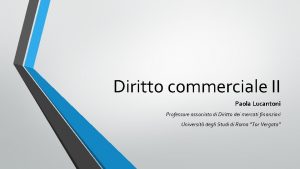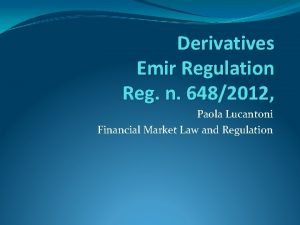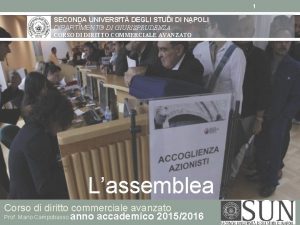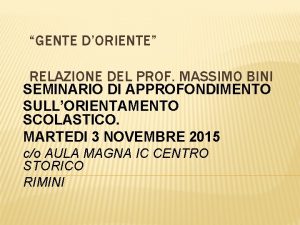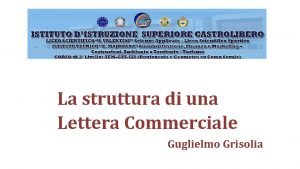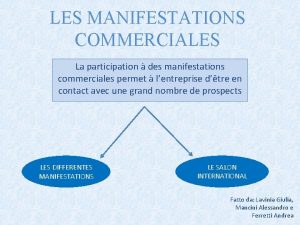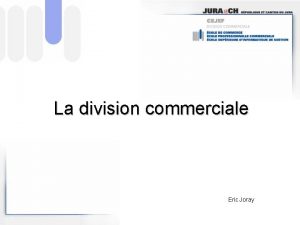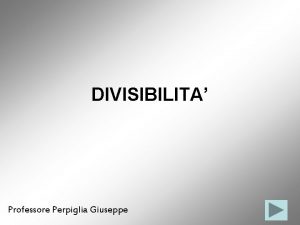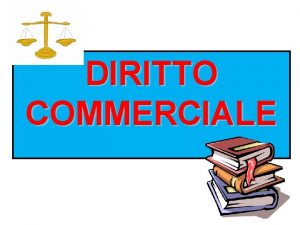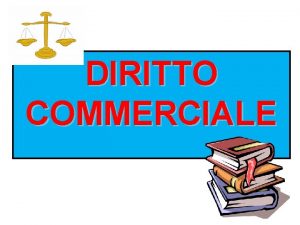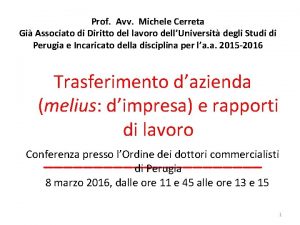Diritto commerciale II Paola Lucantoni Professore associato di



















- Slides: 19

Diritto commerciale II Paola Lucantoni Professore associato di Diritto dei mercati finanziari Università degli Studi di Roma “Tor Vergata”

Programma • • • Corporate Law: What is a corporation. Agency problems and legal strategies. The basic governance structure: shareholders. The basic governance structure: non-shareholders constituencies. Transactions with creditors. Related-party Transactions. Fundamental changes. Control transactions.

Nozioni preliminari • • Imprenditore art. 2082 c. c. Contratto di società art. 2247 c. c. Società di persone • • • Società semplice art. 2251 c. c. Società in nome collettivo art. 2291 c. c. Società in accomandita semplice art. 2313 c. c. Società di capitali • • • Società per azioni art. 2325 c. c. Società a responsabilità limitata art. 2462 c. c. Società in accomandita per azioni 2452 c. c.

Differenze tra società di persone e società di capitali Società di persone. Autonomia patrimoniale imperfetta Creditore particolare Creditore sociale Responsabilità Società di capitali Personalità giuridica

Differenze tra società di persone e società di capitali Società di persone. Corporate governance Amministrazione disgiuntiva Amministrazione congiuntiva Sistema tradizionale di amministrazione Società di capitali Sistema monistico di amministrazione Sistema dualistico di amministrazione

Differenze tra società di persone e società di capitali Società di persone. Autonomia contrattuale Decisioni dei soci Calcolo maggioranze Unanimità Metodo collegiale Società di capitali Decisioni dei soci nelle srl Dialettica assembleare nelle sapa

What is a corporation? • Despite the very real differences across jurisdictions along corporate governance, share ownership, capital markets and business culture among European, American, Japanese, and emerging markets, the underlying uniformity of the corporate form is impressive.

Five legal characteristics Legal personality Investor ownership Delegated management under a board structure Limited liability Transferable shares

Corporate law • Principal function: to provide business enterprises with a legal form that possesses these five core attributes. • Most of corporate law can be understood as responding to three principal sources of opportunism that are endemic to this organization (agency costs): • • • Conflicts between managers and shareholders Conflicts between controlling and non – controlling shareholders Conflicts between shareholders and the corporation’s other contractual counterparties, including particularly creditors and employees.

Corporate law • Role of corporate law: minimizing coordination and agency problems in the most important categories of corporate actions and decisions. • Comparative and functional approach: • The discussion is organized around the ways in which corporate laws respond to these problems, and the various forces that have led different jurisdictions to choose roughly similar solution to them.

Legal personality • Nexus of contracts: the relationships among the firm’s owner, managers, and employees are essentially contractual in character. • Nexus for contracts: the firms serves, fundamentally, as the common counterparty in numerous contracts with suppliers, employees, and customers, coordinating the actions of these multiple persons through exercise of its rights. • The core element of the firm as a nexus for contracts is a “separate patrimony”: • The demarcation of a pool of assets that are distinct from other assets owned, singly or jointly, by the firm’s owner (the shareholders) and of which the firm itself, acting through its designated managers, is viewed in law as being the owner.

Legal personality • The core element of the firm as a nexus for contracts is a “separate patrimony”: • The demarcation of a pool of assets that are distinct from other assets owned, singly or jointly, by the firm’s owner (the shareholders) and of which the firm itself, acting through its designated managers, is viewed in law as being the owner. • The firm’s entitlements of ownership over its designated assets include the rights to use the assets, to sell them and to make them available for attachment by its creditors. • The firm’s assets are unavailable for attachment by the owners’ personal creditors. •

Legal personality • Entity shielding involves two relatively distinct rules of law: • 1. creditor priority rule: a claim to the creditors of the firm on the firm’s assets that is prior to the claims of the personal creditors of the firm’s owners. • 2. liquidation protection rule: individual owners of the corporation (the shareholders) cannot withdrawn their share of firm assets at will

Limited liability • Limited liability as a contracting tool and financing device. • Creditors are limited to making claims against assets that are held in the name of the firm itself, and have no claim against assets that the firm’s shareholders hold in their own names. • Diversification: limited liability imposes a finite cap on downside losses, making it feasible for shareholders to diversify their holdings.

Transferable shares • Fully transferable shares in ownership • Transferability permits the firm to conduct business uninterruptedly as the identity of its owners changes, thus avoiding the complications of member withdrawal that are common among partnership, cooperatives and mutuals. • Counterparties can be confident that the bundle of contracts that constitutes the firm will be kept together, there is no need for a rule requiring owners to continue to participate.

Transferable shares • Fully transferable shares do not necessarily means freely tradable shares. Even if shares are transferable, they may not be tradable without restriction in public markets, but rather just transferable among limited groups of individuals or with the approval of the current shareholders or of the corporation. • As a matter of terminology we refer to corporation with freely tradable shares as open or public corporations; we will correspondingly use the terms closed or private corporations to refer to corporations that have restriction on the tradability of their shares. • Partnerships lack limited liability and transferable shares.

Delegated management with a board structure • Allocation of control rights • Partnerships: general partnership forms usually grant power to a majority of partners to manage the firm in the ordinary course of business, while fundamental decisions require unanimity. • Corporate law typically vests principal authority over corporate affairs in a board of directors elected, exclusively or primarily, by the firms shareholders.

Delegated management with a board structure • Four basic features of the board of directors • • 1. the board is separate from the operational managers of the corporation 2. the board is elected, at least in substantial part, by the firm’s shareholders. • • 3. separation between ownership (shareholders) and control (board) • • Shareholders’ value v/ stakeholders value Mechanism to protect minority shareholders’ rights 4. board with multiple members • Facilitates mutual monitoring

Investor ownership • The right to control the firms • Possible negotiations on voting rights • Classes of shares • The right to receive the firm’s net earnings • Possible negotiation on dividend and final liquidation • Classes of shares
 Paola lucantoni
Paola lucantoni Paola lucantoni
Paola lucantoni Paola lucantoni
Paola lucantoni Ius unitn
Ius unitn Assemblea totalitaria diritto commerciale
Assemblea totalitaria diritto commerciale Dipartimento di diritto privato e critica del diritto
Dipartimento di diritto privato e critica del diritto Kstudio associato
Kstudio associato Massimo bini professore
Massimo bini professore Testo caricaturale
Testo caricaturale La legge morale film
La legge morale film Luigi gaudio professore
Luigi gaudio professore Schema lettera commerciale
Schema lettera commerciale Sodio cromoglicato nome commerciale
Sodio cromoglicato nome commerciale Concetto commerciale
Concetto commerciale Sconto commerciale formula
Sconto commerciale formula Manifestation commerciale exemple
Manifestation commerciale exemple Le partizioni del diritto
Le partizioni del diritto Ecole de commerce porrentruy
Ecole de commerce porrentruy Agence de prospection
Agence de prospection Définition veille mercatique et commerciale
Définition veille mercatique et commerciale

